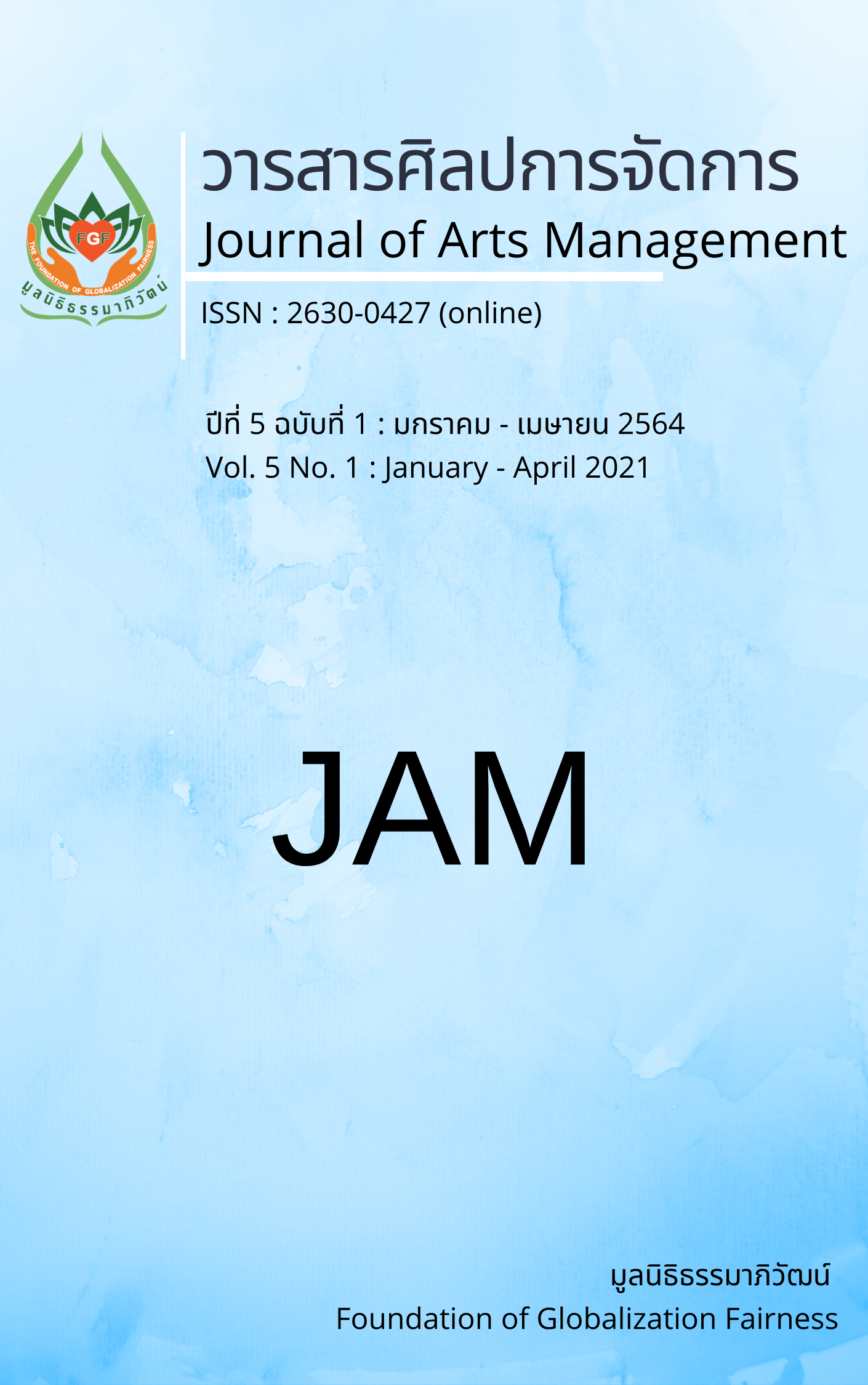The Influence of Causal Factors on Purchasing Intention TOEIC Online Course of Consumers in Bangkok and Its Vicinity
Main Article Content
Abstract
The objectives of this research were to develop and validate the consistency a causal of relationship model of purchasing intention of TOEIC online course of consumers in Bangkok and Its Vicinity. This study was a quantitative research. The sample group consisted of 430 people who have been bought TOEIC online course. The tools used in the research were online questionnaires. The statistics used in data analysis were frequency, percentage, mean, standard deviation, skewness value, and kaleidoscope. The results of this research were the structural equation model was used to analyze causal relationships to find the path to the causal influence of the variables consisting of 4 components were 1) Brand Image, 2) Discounted Price, 3) Consumer Attitudes, and 4) Purchase Intention and the model was consistent with the empirical data to a greater extent. The statistic showed the Chi-square statistics goodness fit test (χ2) = 216.58, degrees of freedom (df) = 121, CMIN / DF = 1.79, GFI = 0.95, AGFI = 0.92, SRMR = 0.05, RMSEA = 0.04 2. The final was predictive coefficient of 0.51, indicating that the variables in the model can explain the variance of the Purchase Intention of TOEIC online course by 51 percent. It was found that the Consumer Attitudes were the most influence on Purchasing Intention TOEIC Online Course of The Consumers in Bangkok and Its Vicinity. The results of this research are useful for entrepreneurs, tutorial school online businesses are utilized to a marketing plan and create marketing strategies that are suitable for consumers. Resulting in purchasing intention of the online course in the future.
Article Details
Views and opinions appearing in articles in the Journal of Arts of Management It is the responsibility of the author of the article. and does not constitute the view and responsibility of the editorial team I agree that the article is copyright of the Arts and Management Journal.
References
กริช แรงสูงเนิน. (2554). การวิเคราะห์ปัจจัยด้วย SPSS และ AMOS เพื่อการวิจัย. กรุงเทพฯ: ซีเอ็ดยูเคชั่น.
กิตติมา แซ่โห. (2559). ภาพลักษณ์การท่องเที่ยว ภาพลักษณ์คุณภาพการบริการ และค่านิยมในการท่องเที่ยวที่ส่งผลต่อทัศนคติการท่องเที่ยวแบบยั่งยืน: กรณีศึกษาการท่องเที่ยวไทยทางธรรมชาติของนักท่องเที่ยวชาวไทยวัยทำงานในเขตกรุงเทพมหานคร (วิทยานิพนธ์ปริญญามหาบัณฑิต). มหาวิทยาลัยกรุงเทพ.
เกรียงไกร แสงเพ็ชร และสมชาย เล็กเจริญ. (2562). โมเดลความสัมพันธ์เชิงสาเหตุความตั้งใจซื้อคอร์สเรียนออนไลน์ผ่านเฟซบุ๊กของผู้บริโภคในเขตกรุงเทพมหานครและปริมณฑล. การประชุมวิชาการระดับชาติ ไอซีทีศิลปากรวิชาการ ประจำปี 2019 วันที่ 6 พ.ค. 2562, 529 – 540.
ไซมอน โชติอนันต์ พฤทธิ์พรชนัน. (2554). จิตวิทยาการตลาด (Psychological factors). สืบค้นเมื่อ 9 ธันวาคม 2562. จาก http://graduate.east.spu.ac.th/…/know…/A198Psychological.pdf
ธนภณ นิธิเชาวกุล. (2559). ทัศนคติของผู้บริโภคต่อภาพลักษณ์ตราสินค้าและกลยุทธ์ทางการตลาดของร้านขายของที่ระลึกผลิตภัณฑ์ OTOP ในเขตเมืองพัทยา จังหวัดชลบุร (วิทยานิพนธ์ปริญญามหาบัณฑิต). มหาวิทยาลัยบูรพา.
นงลักษณ์ วิรัชชัย. (2542). โมเดลลิสเรล: สถิติวิเคราะห์สำหรับการวิจัย. (พิมพ์ครั้งที่ 3). กรุงเทพฯ: โรงพิมพ์แห่งจุฬาลงกรณ์มหาวิทยาลัย.
สมบัติ คชสิทธิ์, จันทนี อินทรสูต และธนกร สุวรรณพฤฒิ. (2560). การจัดการเรียนรู้ภาษาอังกฤษให้กับผู้เรียนยุค THAILAND 4.0. วารสารวไลยอลงกรณ์ปริทัศน์ (มนุษยศาสตร์และสังคมศาสตร์), 7(2), 177-181.
สำนักงานพัฒนาธุรกรรมทางอิเล็กทรอนิกส์. (2562). รายงานผลการสำรวจพฤติกรรมผู้ใช้อินเทอร์เน็ตในประเทศไทย ปี 2562. สืบค้นเมื่อ 9 ธันวาคม 2562. จาก https://www.everydaymarketing.co /trend-insight/etda-2020-thai-internet-behaviour/
หิรัญ หิรัญประทีป. (2558). ภาพลักษณ์และทัศนคติที่ส่งผลต่อการตั้งใจซื้อเครื่องสำอางในร้าน Drugstore ในเขตกรุงเทพมหานคร. (การศึกษาอิสระปริญญาบริหารธุรกิจมหาบัณฑิต). มหาวิทยาลัยกรุงเทพ.
เว็บไซต์ Marketeer. (2019). สถาบันสอนภาษาอังกฤษ บูม! แบบ Strong เพราะ คนไทยยังใช้ภาษาอังกฤษหาเงิน. สืบค้นเมื่อ 20 ธันวาคม 2563. จาก https://marketeeronline.co/archives/78710
อรรชนิดา หวานคง. (2559). การจัดการเรียนการสอนภาษาอังกฤษในศตวรรษที่ 21. วารสารสถาบันวิจัยญาณสังวร, 7(2), 304-314.
Aaker, D. A. & Keller, K. L. (1990). Consumer evaluations of brand extensions. Journal of Marketing, 54(1), 27-41.
Banerjee, S. (2009). Effect of product category on promotional choice: comparative study of discounts and freebies. Management Research News, 32(2), 120.
Bendall, L. & Thomas, L. P. (2004). The impact of structure and process attributes on satisfaction and behavioral intentions. Journal of Services Marketing, 18(2), 114-121.
Biswas, A., Pullig, C., Yagci, M. I. & Dean, D. H. (2002). Consumer evaluation of low price guarantees: The moderating role of reference price and store image. Journal of Consumer Psychology, 12(2), 107-118.
Chao, R.-F. & Liao, P.-C. (2016). The Impact of Brand Image and Discounted Price on Purchase Intention in Outlet Mall: Consumer Attitude as Mediator. The Journal of Global Business Management, 12(2), 119-128.
Cretu, A. E. & R. J. Brodie. (2007). The influence of brand image and company reputation where manufacturers market to small firms: A customer value perspective. Industrial Marketing Management, 36(2), 230-240.
Davis, F. D. (1989). Perceived Usefulness, Perceived Ease of Use, and User Acceptance of Information Technology. MIS Quarterly, 13(3), 319-340.
Ekankumo, B. & Henry, K. B. (2011). Sales Promotion Strategies of Financial Institutions in Bayelsa State. Asian Journal of Business Management, 3, 203-209.
Henderson, P. W., Cote, J. A., Leong, S. M. & Schmitt, B. (2003). Building strong brands in Asia: Selecting the visual components of image to maximize brand strength. International Journal of Research in Marketing, 20(4), 297-313.
Rosenberg, M. J. & Hovland, C. I. (1960). Cognitive, Affective and Behavioral Components of Attitudes. In: Rosenberg, M. J. & Hovland, C.I., Eds., Attitude Organization and Change: An Analysis of Consistency among Attitude Components, Yale University Press, New Haven.
Robinson, C. & Barlow, W. (1959). Image. Public Relation Journal, 22(2), 152-168.
Sierra, J. J. & Hyman, M. R. (2011). Outlet mall shoppers' intentions to purchase apparel: A dual-process perspective. Journal of Retailing and Consumer Services, 18(4), 341-347.
Thurstone, L. L. & Chave, E. J. (1966). The Measurement of Attitude. Chicago: Chicago University.
Zeithaml, V. A., Parasuraman, A. & Berry, L. L. (1990). Delivering Quality Service, New York: The Free Press.


